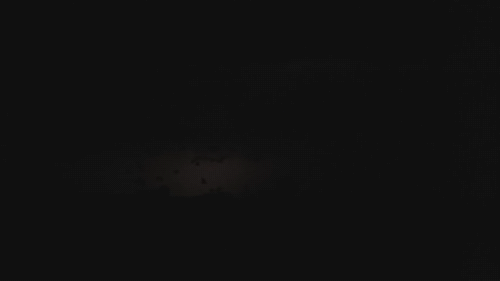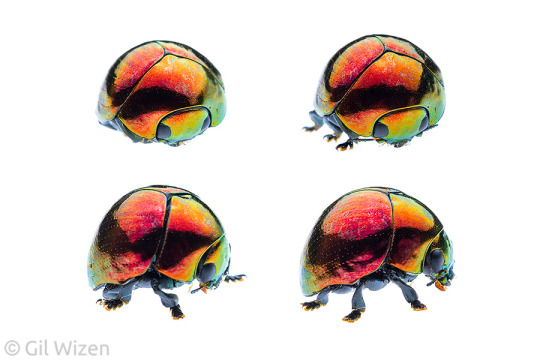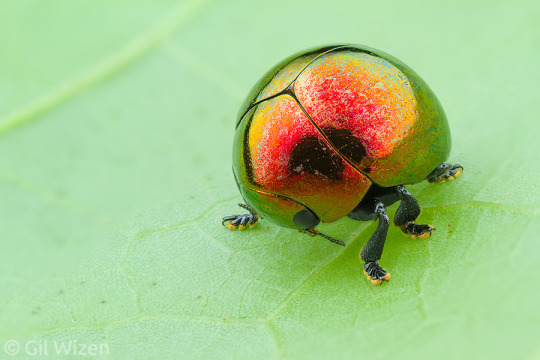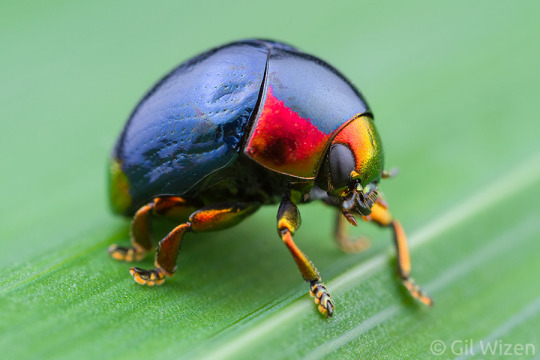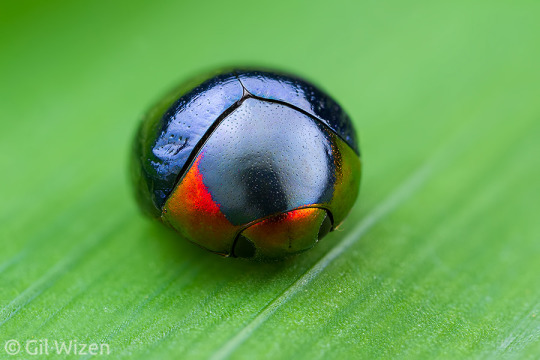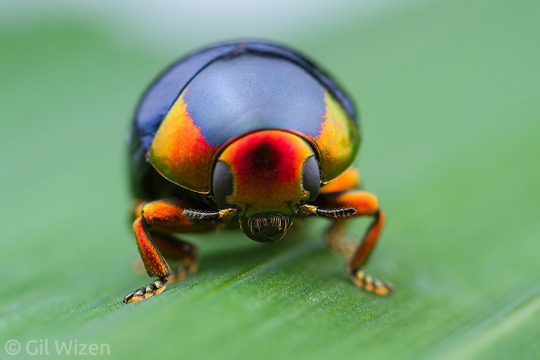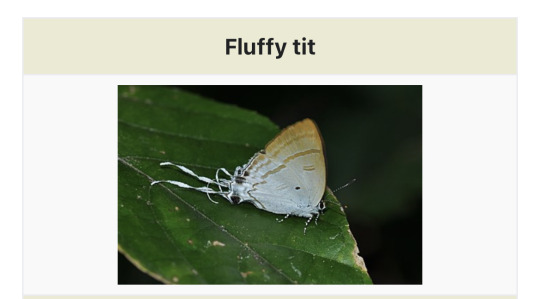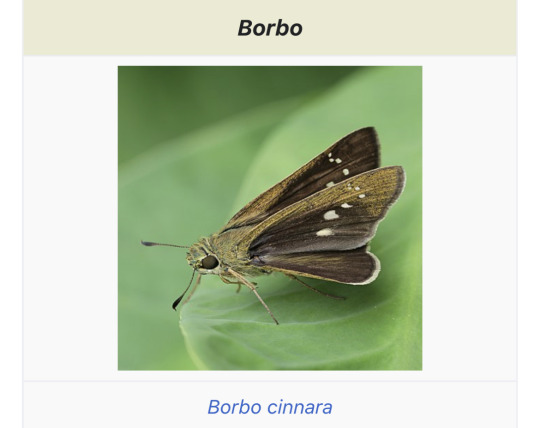Behavioural Ecology, Evolution, and Entomology (bugs)! I also like birds, fish, amphibians, and reptiles. Mammals are ok, I guess 😉. I have a MSc in biology, and I want to go for my PhD, but we'll see. I'm also a person (they/them/she/he/idk you pick), I have ADHD, and i've been hyperfixated on various bits of biology since... well, I don't actually remember a Before Time!
Don't wanna be here? Send us removal request.
Text
Fun Fact: Goldenrod does NOT cause seasonal allergies!
At this time of year, I am suffering from seasonal allergies (ಥ_ಥ). And in honor of these seasonal allergies, I’d like to clear the good name of an innocent plant which has long been blamed for seasonal allergies.
Ahem:
Goldenrod is INNOCENT!!!!!
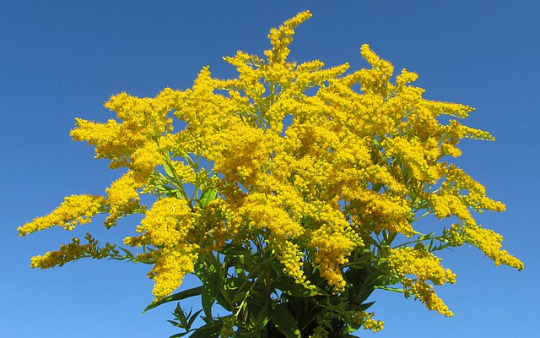
(I love goldenrod (Solidago spp.) and WILL NOT STAND FOR THIS SLANDER)
Now, that isn’t to say that no one is allergic to goldenrod, at all. Some people are, indeed, allergic to this plant, but it is relatively rare and only cause reactions when direct physical contact takes place. These goldenrod allergies do NOT cause the stuffy noses and watery eyes that seasonal allergy sufferers are familiar with (and which I am currently suffering from 😭😭😭😭).

(an innocent bystander 😔)
“But wait!”, you may say, “Every year, without fail, seasonal allergies attack just as the goldenrod begins to bloom!” And this is a fair assumption! There are many times in life where the things we see are causing the things we experience. However, in this case, seasonal allergies and goldenrod flowers are connected by correlation, not causation.
How can I be so sure? Well, because goldenrod pollen is not airborne!
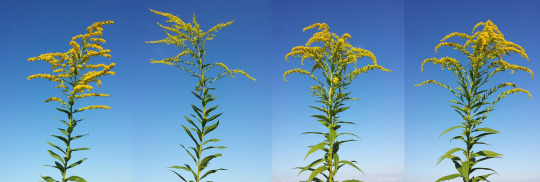
(they’re so good, so pure, so not-currently-attacking-my-airways)
Goldenrod is a plant which is pollinated by animals, primarily insects. Because of this, its pollen is big, heavy, delicious and can’t make it too far from the plant, even with a BIG gust of wind. Instead, an insect covered in goldenrod pollen will fly to a different goldenrod plant, transporting and delivering the pollen in a highly efficient manner, because that is where the plant intends for the pollen to go! Really, goldenrod pollen is unlikely to ever get into your nose (unless you sprinkle it in directly).
Instead, the culprit for your seasonal allergies is MUCH more likely to be an enemy you may have heard of: ragweed.

(*holds up sign that says “Audience Boos”*)
It just so happens that ragweed (Ambrosia spp.) and goldenrod (Solidago spp.) both bloom around the same time, and in the same sorts of environments.
Goldenrod is bright yellow and extremely conspicuous, while ragweed…. well, it doesn’t exactly jump out, visually:
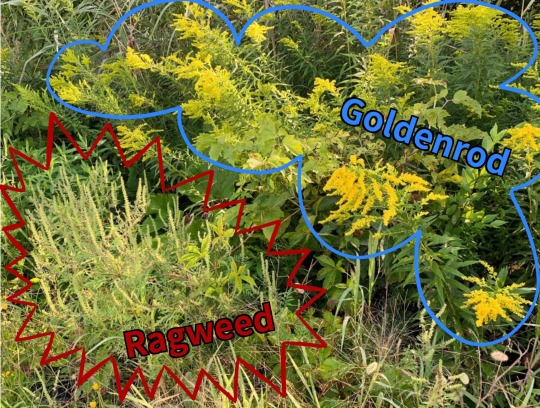
(I circled and labelled them because the ragweed doesn’t exactly… pop out of the picture. ©Janet Allen)
People notice their allergies and then notice the highly conspicuous goldenrod, and they consider the mystery solved. Meanwhile the ragweed remains, hidden in plain sight and the TRUE guilty party.
Ragweed is my eternal enemy the most common cause of seasonal allergies in North America. One reason for that is because ragweed, rather than being pollinated by insects, is instead pollinated via wind, which basically means the plants produce a LOT of very tiny, airborne pollen (about a billion particles per plant), and just hopes that one lands on a different ragweed plant eventually, travelling up to 600 km away. Unfortunately for allergy sufferers, the vast majority of the pollen does not make it to another plant and apparently ends up in my nose instead.
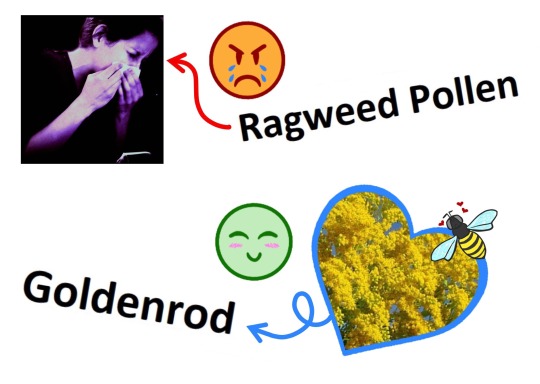
(things that do cause my allergies: ragweed, horses, and mold spores. Things that do NOT cause my allergies: goldenrod.)
Now, I am being a little bit mean to ragweed here, but in my defence, I cannot currently breathe through my nose as a direct result of ragweed, and it has put me in a mean sort of mood (ಠ╭╮ಠ). this is my villain origin story.
That said, I would be remiss not to mention that ragweed is native to North America (although they are VERY invasive in many other places in the world), and so it… I’m sure… that ragweed… it contributes… to the ecosystem… somehow… and we should respect it… instead of assigning… subjective value judgements… to nature (I say, shaking, crying, visibly pained).
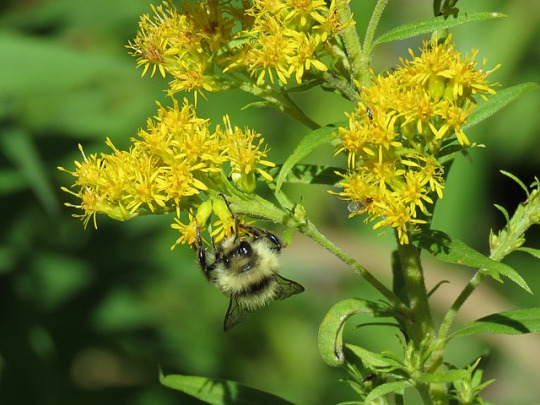
(a bumblebee (Bombus sp.) enjoying some goldenrod 🥰)
Goldenrod, on the other hand, is native to North America and is ONE OF MY FAVOURITE THINGS, simply because pollinators LOVE these flowers! I can sit for literal HOURS at a single plant, watching the dozens of different pollinators coming and going. It is also invasive in many other places in the world but THIS ISN’T ABOUT THAT 😭😉😉😉
This has been Fun Fact Friday, where I will defend the honour of goldenrod with my life!
(also: guys there are SO MANY pictures of goldenrod on the internet mislabeled as ragweed, it’s actually blowing my mind. Stock image sites are particularly terrible about this. THE WORLD NEEDS TO KNOW THE TRUTH.)
177 notes
·
View notes
Note
Evolution question. I know evolution happens by having 1) variation and 2) outside forces that give advantage to specific variations, and those with disadvantage either die or don't have babies. I also know today humans are "survival of pretty much anyone" rather than "survival of the fittest/most suited", because we have things like healthcare (society being terrible notwithstanding). So how are we still evolving things like lighter bones? Those with heavy bones aren't dying young, and I'm not asking someone if they have heavy bones before making babies with them. I saw medicalnewstoday.com say human evolution is "100x faster"?
Sorry for the slow reply, I have depression.
The first thing you need to know is that everything that reproduces is always evolving, which includes humans. While most people think of evolution in terms of BIG changes, such as new traits and adaptations arising (and eventually leading to new species), evolution is ACTUALLY all about changes in gene variants over time.

(art is my passion)
I know that “changes in gene variants over time” is a weird collection of words, so, to quickly give some context: all humans have the same basic set of genes, but variations of those genes differ from person to person. For example, two random people will both have the collection of genes required for eyes, but one person may have a gene variant for brown eyes and the other blue eyes, or one of them may have a gene variant that causes an astigmatism (thanks, dad). These gene variations are also known as “alleles”.

Reproducing leads to alleles being passed on, which increases their frequency. When an allele is useful, people with that allele tend to have more offspring, which leads to the allele frequency increasing. When an allele causes problems, it tends to decrease in frequency over time. When an allele is neutral, it can increase and decrease randomly in frequency, which is called “genetic drift”. All of these processes happen passively, and even if there are fewer "selective pressures" (such as dying from easily treatable infections), then genetic drift is still occurring, which means evolution is still occurring.
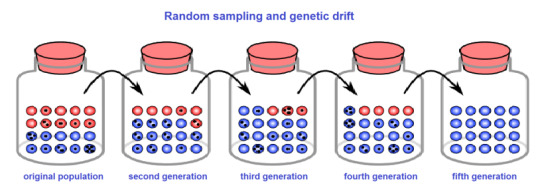
(red and blue both represent neutral alleles, but with random sampling, the red allele still disappeared! neat!)
The SECOND thing you need to know is that "survival of the fittest" doesn't necessarily mean evolution is ONLY about the fittest surviving. Honestly I think the term "survival of the fittest" is a bit misleading. A more accurate statement would be "the alleles which impart traits which are more advantageous in a given environment tend to increase in frequency over long periods of time relative to other alleles", but I admit that that isn’t as punchy on a t-shirt.
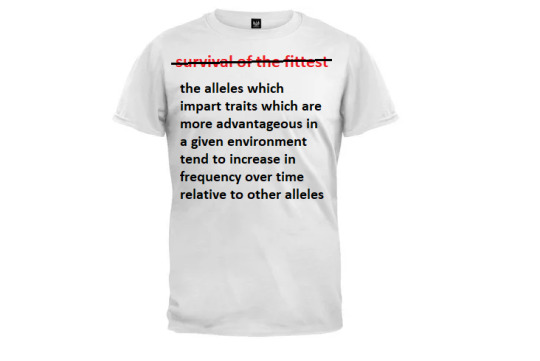
(I'd wear it)
This means that it isn’t just about reproducing and not reproducing. It’s also about relative reproduction. If one person (individual A) has one child, and another person (individual B) has three children, then individual B was 3 times more successful, reproductively, and over a long period of time (assuming a similar rate in reproduction in each generation), this leads to BIG differences.

See? They both survived, and they both reproduced, but after only 3 generations, one has FAR more descendants! Just imagine the difference in 10 generations, or 100 generations, or 1000 generations!
Now, consider a theoretical example of two people who have the exact same amount of baby-having desire (lets say they both want 3 babies), but one of them has heavier bones (which I’m going to PRETEND would make it more likely to break a bone, based on literally nothing at all). As a result, they break a bone every five years or so, which perhaps leads to long-lasting issues, such as chronic pain. They will almost definitely survive, and will probably even reproduce, even without the intervention of modern medicine. But they’re likely to have fewer children than the person who wasn’t breaking their legs, relatively speaking, because they spent more time and energy healing instead of having more babies.

(I've decided these theoretical people are both happy as individuals, even though one was TECHNICALLY less "successful", reproductively)
Over time, this difference in "reproductive success" would lead to populations with lighter bones overall.
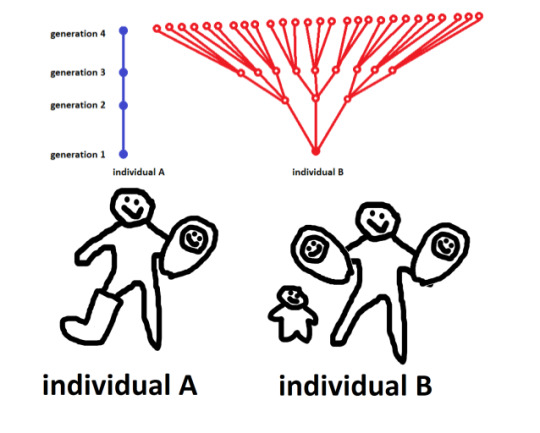
Imagine if, for both groups of descendants, one person in generation 4 decides not to have children. For the descendants of individual B (and their alleles), this is no big deal, because there are 26 other individuals who might still have children. But for descendants of individual A, this would mean their heavy-boned allele would not be passed on at all!
Now, this doesn't mean heavier-boned people will necessarily die or have no babies. It just means that, over a long period of time, due to genetic drift, heavier bones are more likely to eventually disappear, just from random chance. There's also a fair chance that they'll stick around, just in lower numbers than those with lighter bones.
This is what I would call evolution of modern humans! In basic terms, at least.
Finally, you should know that the "100x faster evolution" term is more of a case of narrative hyperbole rather than a number that represents any mathematical model of actual evolutionary change. The book it came from is reportedly interesting, but has a problem of just saying things without very much supporting evidence, so reviews are mixed.
Any questions?
124 notes
·
View notes
Text
Fun Fact: The birds known as “Goat suckers”
So. This week is a little different, just for fun! We’re going to get into the etymology of a group of birds, with a little bit of folklore mixed in, because I think it’s neat!
Since you are on the internet, you may be familiar with Caprimulgiformes. Well. That name is A Lot, so you probably don’t know them by that name, but they are an Order of birds that includes such internet sensations as Frogmouths and Nightjars and Whip-poor-wills.
Another term for them is “Goat suckers”.
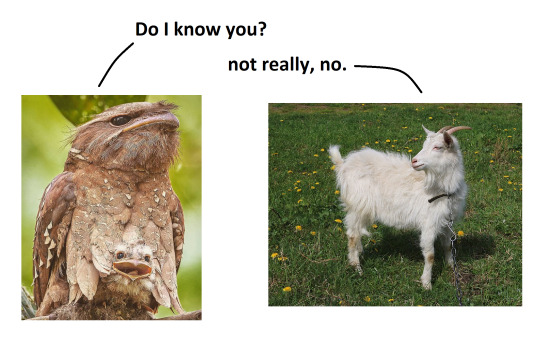
Why? Let me explain:
The Order name “Caprimuliformes” can be broken into two basic parts:
Capra: (latin) “goat” (yes, like capricorn).
mulgeō: (latin) “I milk”
Which, in turn, can be combined to create the word:
caprimulgus: (latin) “goat milker”. At some point, people started translating this as “goat sucker”, and I am not one to disagree, on account of it being a funnier name, in my correct opinion.
This is not to be confused with another so-called goat-sucker: el chupacabra (Spanish: chupar, ‘to suck’, and cabras, 'goats’). I guess everyone is very worried about their goats getting– actually, nevermind.
Caprimulgiformes are aerial insectivores, meaning they capture insects out of the air. In many parts of the world, people have noticed that they like to hang out around goats (and other herd animals, but lets focus on the goats). Why? Well, the real reason is because bugs are attracted to the goats, and these birds are attracted to the bugs. These birds also happen to be nocturnal.
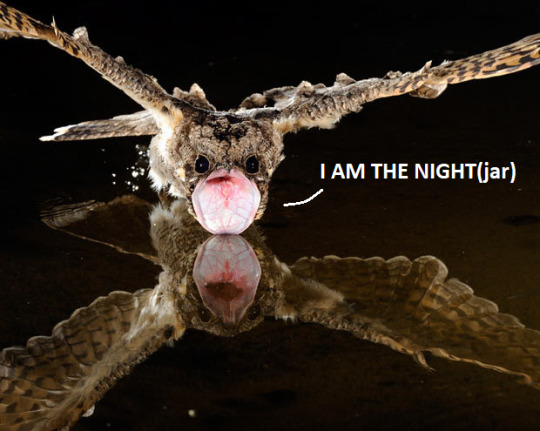
Now, if these birds caught bugs during the day, they would probably have a different name, and this would likely be the end of the story. However, the fact that they appear at night, swooping low over the goat herds for mysterious reasons, is something that goat herders in ancient Greece apparently found to be very untrustworthy.
You see, sometimes, nanny goats suddenly stop producing milk. This can happen for a variety of reasons, and these reasons are often not obvious. And when ancient goat herders discovered a goat suddenly wasn’t producing milk one morning, they, like all humans, want to know the reason.
So they thought to themselves: what could have happened since yesterday to cause this? What have I seen? What have I noticed?
And they remember those birds, which only appear at night, and swoop low over the heads of their goats for no discernible reason. And those goat herders thought to themselves: huh. Maybe they stole the milk.
at least, this is how I imagine the reasoning went
This was likely not helped by the goatsuckers’ mouths, which look like this:
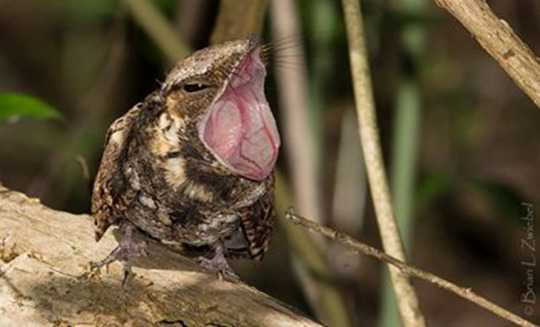
I suspect ancient Greek goat herders thought that looked about right for stealing goat milk. Like. It’s around the right size to fit around a goat teat. They’re actually like that because they’re essentially ram-feeders, meaning they open their mouth and fly through a swarm of insects, trying to catch as many as they can. Bigger mouth = more bugs.
At any rate, we know that people thought this, because this guy you may have heard of, Pliny the elder, passed on this little pearl of wisdom in 77 CE (quote from a 1601 translation):
“The Caprimulgi (so called of milking goats) […] bee night-theeves; for all the day long they see not. Their manner is to come into the sheepeheards coats and goat-pens, and to the goats udders presently they goe, and suck the milke at their teats. And looke what udder is so milked, it giveth no more milke, but misliketh and falleth away afterwards, and the goats become blind withall.”
Dang. They also make goats go blind? Powerful little birds, I guess!
Nowadays, I’m not sure if anyone really believes this bit of folklore. Maybe it exists in small communities, but I don’t know of any. Even in 77 C.E., Pliny seemed a bit doubtful of this fact. In another bit of writing, where he recounts an old man telling him about the harms of goatsuckers, he ends the story with the line “But possibly that aged man was jesting with me.” (quote from Dictionary of American Bird Names).

(bonus:
In my area, we have the “whip-poor-will”, because their call sounds like they’re repeating “whip-poor-will” over and over and over and over and over and over and over. They also happen to be nocturnal, and love to call at around 2am right outside my tent. (I still love them but also oh my god let me rest). Here’s a recording of their call if you want a taste. )
1K notes
·
View notes
Text
self-reblog for Pride Month!
Fun Fact Friday: There are Species of Lesbian Lizards!
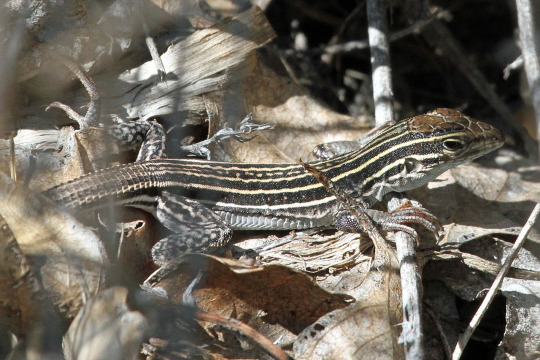
This is a New Mexico Whiptail Lizard (Aspidoscelis neomexicanus), and I am 100% sure that this lizard is a female! How can I know?
Well, because every New Mexico Whiptail Lizard is a female!
There are about 45 species of whiptail lizards (which used to be one genus but then were sorted mostly into the genera Aspidoscelis and Cnemidophorus), at least 15 of which are “unisexual” species, i.e. all-female species.
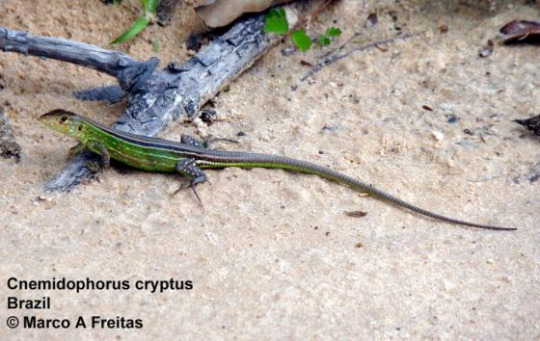
(some species are fun colours!)
These lizards reproduce exclusively via parthenogenesis, which basically means they clone themselves every time they reproduce, laying eggs that contain genetically-identical offspring. Now, normally I would call such a species asexual lizards, to get some of that good ace rep, but here’s the thing:
These all-female lizards still mate with each other.

(gal pals! 😉)
Every breeding season, these lizards go through same-sex mating behaviours, including lengthy courtship rituals, which culminates in one female lizard mounting the other.
This process can last more than 10 minutes.

(I love this paper)
Without same-sex mating, a female might lay one or two eggs in a breeding season. Maybe. With same-sex mating, a female can lay up to 9 eggs in a season! That’s 2-3 clutches with 2-3 eggs in each, and a HUGE increase in reproductive success!

A BBC clip about these lizards from 2010 claims that the “male-like” behaviour of the females is caused by an increase of “the male hormone testosterone”, but that’s actually not true. At all.
The BBC lied to me about Lesbian Lizards!!!
In reality, testosterone levels stay uniformly low throughout the breeding season, while the cycling of estrogen and progesterone are what triggers the different mating behaviours. Neither of these hormones are generally referred to as “male” hormones.
(git gud, BBC. Honestly, this 2 minute clip has a bunch of mistakes, mostly to increase the Drama, but whatever, I guess).

(one of my favourite graphs in anything, tbh)
Before the ovulation, the lizard’s levels of estrogen increases, leading to “female-like” mating behaviour. After mating, but before the eggs are laid, estrogen drops off a clip while progesterone peaks, and the female goes off to mate with other females, this time in the “male-like” role.

(This one is A. exsanguis, which is fun because it’s name means “lacking blood” although I am 99.999999% sure that they do have blood)
Once the eggs are laid, the female has a period of inactivity, probably because laying eggs is a lot of work and she doesn’t have the TIME or ENERGY to deal with the ups and downs of courtship.
(Seriously, though, it probably is a way to recover after the metabolically-taxing work of reproduction. Let the new mom REST).
This has been Fun Fact Friday, telling you the story of the Lesbian Lizards because I love lesbian lizards so much you guys you don’t even know.
Also, my city celebrates Pride in August, so Happy Pride to All! (But especially to Lesbian Lizards, my beloved)
Oh, look. More Sources:
Keep reading
475 notes
·
View notes
Text
Fun Fact: Many Frogs get through Winter... Underwater
Many people have heard of the legendary frogs that are able to freeze solid and survive the winter. (if not, I did write a whole post about it. so.)
This post is not about those frogs. Though amazing, they are the exception rather than the rule. It is much more common for frogs to overwinter in other ways!
The most common strategy to survive winter is to simply live somewhere that does not have winter!
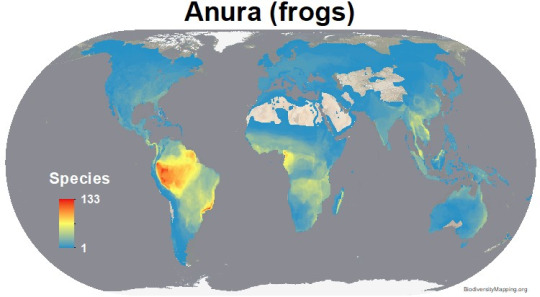
(you’ll notice there are more species of frog closer to the equator. this is not a coincidence. image source)
But some frogs don’t HAVE that luxury! SOME frogs have to deal with a winter that lasts close to 6 entire months!

(im suffering)
The majority of frogs that face this threat survive by either digging underground, or by finding a permanent body of water and just... chilling 🥶😎.

(I will not apologise for my excellent jokes. image source)
Ice is less dense than water, which is why ice burgs exist, among other things. Water is at its densest around 4°Celcius. The 4°C sinks, which means that, in the wintertime, the unfrozen bottom of the pond will (generally) not get colder than 4°C.
Additionally, frogs are ectotherms, aka “cold-blooded”, and as their body temperature drops, so too does their metabolism. This makes it so the frogs can go a long time without food, and also allows them to get by without much oxygen.
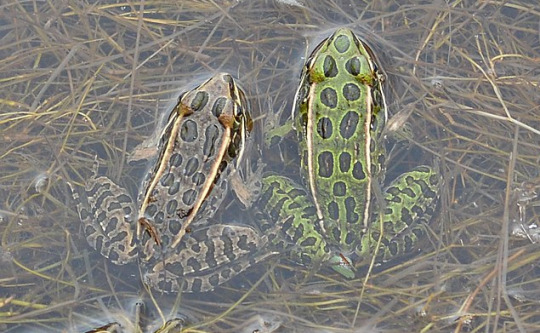
(i love them. image source)
Frogs still need some oxygen, though, so it’s a good thing that frogs are able to absorb oxygen through their skin, just like most amphibians (all amphibians? i can’t think of an exception, but there are so many frog species that I don’t want to commit to a big word like “all”).
Generally, they’ll stay at the bottom of the pond, in a spot that has enough water flow to provide sufficient oxygen for the frogs’ diminished metabolic needs! They generally don’t bury themselves in the mud, though. That part of the pond is nearly devoid of oxygen, and also where the turtles are hibernating!
Here are some pictures of frogs overwinter underwater:

(image sources, in order: mink frog, Green Frog, Bull Frog, fire-bellied toad, marsh frog, siberian wood frog, northern Leopard Frog.)
was this an excuse to show y’all a bunch of pictures of frogs that I like? Yes.
(also please note: second last frog is a siberian wood frog, NOT an american wood frog, and they DO overwinter underwater (Berman et al. 2019). They’re special because they can survive months with very little oxygen, or maybe even no oxygen at all! Good for them 😊)
This has been Fun Fact Friday, letting you know that when the frog gets cold, the frog goes to bed for 6 months. Honestly same.
Sources under the cut!
Berman, D. I., Bulakhova, N. A., & Meshcheryakova, E. N. (2019). The Siberian wood frog survives for months underwater without oxygen. Scientific reports, 9(1), 1-7. [PDF]
Jenkins, C. N., Pimm, S. L., & Joppa, L. N. (2013). Global patterns of terrestrial vertebrate diversity and conservation. Proceedings of the National Academy of Sciences, 110(28), E2602-E2610. [PDF]
How do frogs survive winter? Why don't they freeze to death? Scientific American: https://www.scientificamerican.com/article/how-do-frogs-survive-wint/
#fun fact friday#fun fact#science#frogs#frog#biology#sciblr#science side of tumblr#STEM#adhd in STEM#zoology#winter
512 notes
·
View notes
Text
this genre of tiktok is so good
16K notes
·
View notes
Text
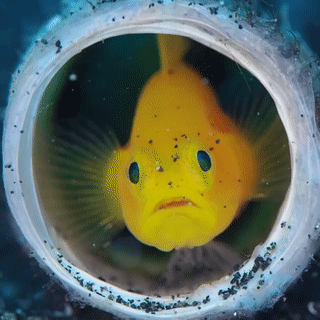

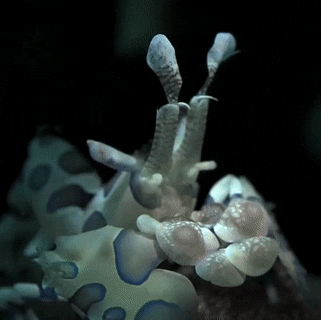
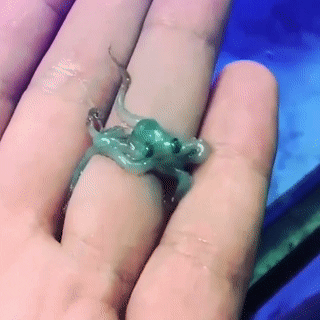
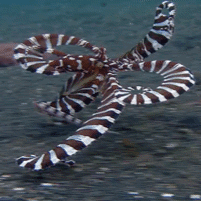
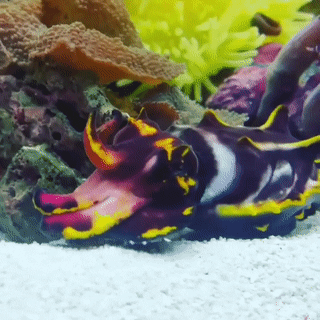
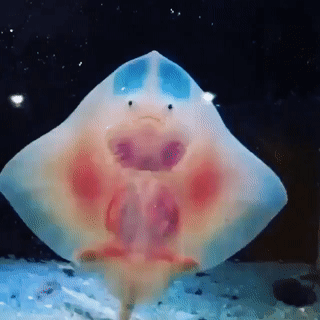
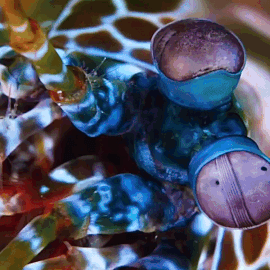
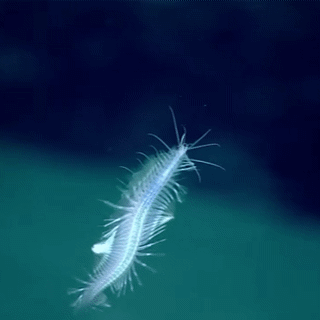
sea creature stimboard for @vernalloy :•]
[ID: A 3x3 stimboard of 9 GIFs.
GIF 1: A yellow pygmy goby, a medium sized fish, hiding in a hole and opening and closing its mouth, it's cheeks expanding and deflating.
GIF 2: A pinnate batfish, a small all-black fish outlined in yellow, swimming in place.
GIF 3: A harlequin shrimp, an off-white shrimp with blue spots, moving its limbs but sitting still.
GIF 4: A very small green octopus crawling on a light-skinned hand.
GIF 5 (center): A wonderpus octopus mimicking a lionfish, appearing to have brown and white stripes, and swimming quickly along the ocean floor.
GIF 6: A flamboyant cuttlefish, a dark purple cuttlefish with yellow accents and shifting white stripes, sitting amongst plants.
GIF 7: A baby clearnose skate, a small stingray thats translucent so it's organs are visible, swimming upwards, the bottom of it and its face visible.
GIF 8: A mantis shrimp, a blue shrimp with multiple coloured spots, cleaning its eyes.
GIF 9: A scale worm, a small sea worm with many thin hair-like legs, swimming upwards.
End ID]
629 notes
·
View notes
Text
Meet microdon fulgens, the rainbow ant fly! This large gorgeous beastie is a (harmless) nectar feeder as an adult, and tricks ants into raising their larvae as their own. I had not heard of this life cycle in flies before, so this was cool to find and learn. Plus, *gestures at fly* 💚💚
5/27/23. N. FL
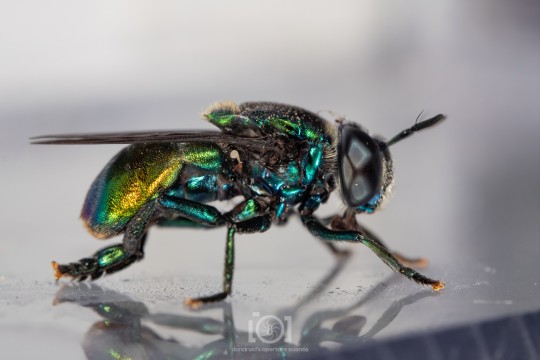

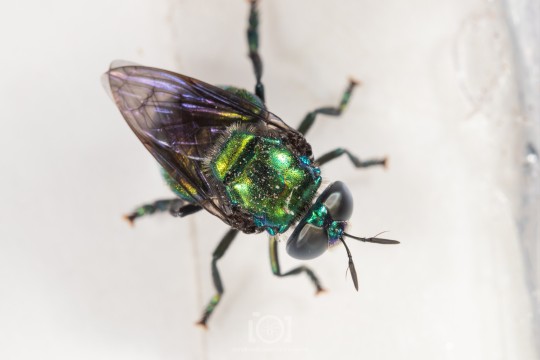

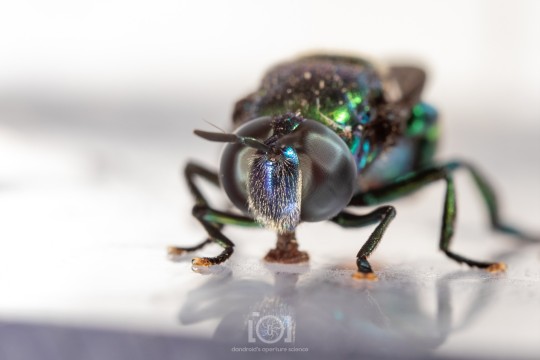
791 notes
·
View notes
Photo


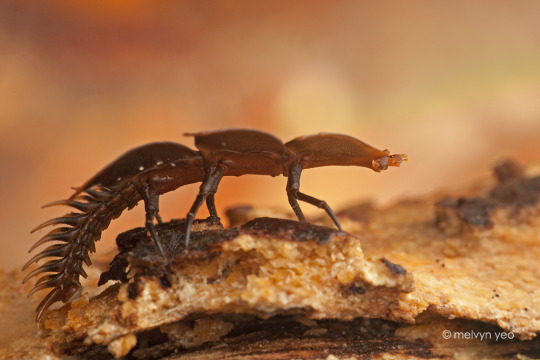
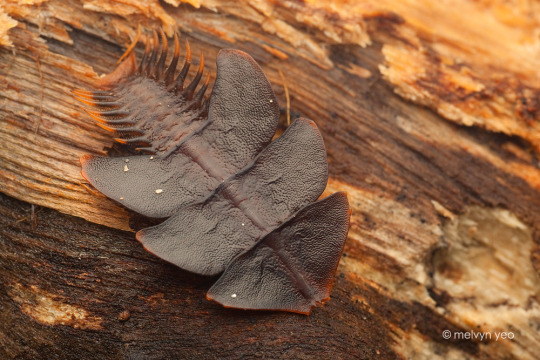

Read more about trilobite beetles and larva here!
Photos by melvynyeo
59K notes
·
View notes
Text
did you know?
you love chubby springtails.
you love them. you have to.
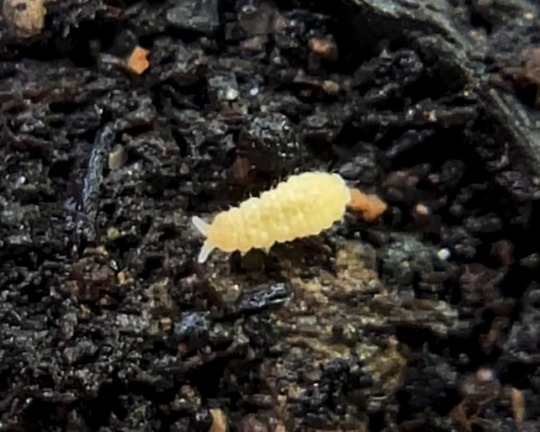


(likely Sensillanura sp., Vitronura giselae and Neanura muscorum)
25K notes
·
View notes
Text

Reptiles (and also amphibians!) from the Petit Larousse.
245 notes
·
View notes
Text
moth update ! theyre threatening me
70K notes
·
View notes
Text
Fun Fact: Hognose snakes are dramatic lil guys!
I am particularly fond of the snakes known as hognose snakes, and my reasons are both understandable and correct.
This is a hognose snake:
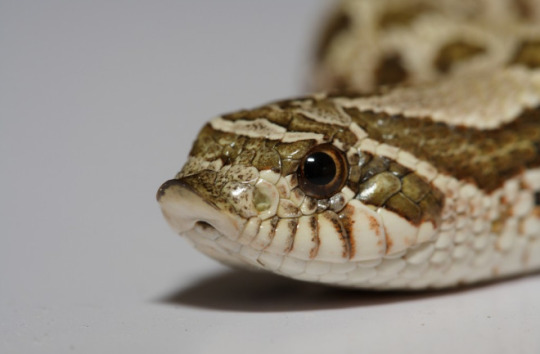
(They received their name by having the sweetest lil snoot to ever require a boop – image source)
They use these adorable snoots to burrow under sandy soil using a sort of nuzzle-y motion. They then use these burrows as a place to sleep at night, hibernate in the winter, and lay their eggs.

(you could say they’re into… the Underground Scene! …ok yeah i’ll show myself out – image source)
Plus, they come in a variety of delightful colours!
We’ve got brown! Beige! Yellow! Black! Red! Orange! Tan! Kinda greenish! Orange again!
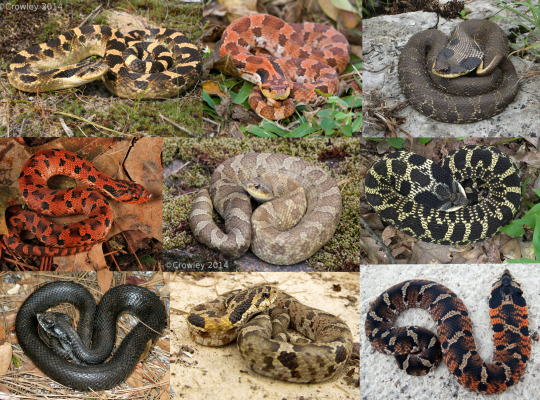
(pretty sneks! – Here’s all the image sources: 1, 2, 3, 4, 5, 6, 7, 8, 9)
And, to be clear, the snakes pictured above are wild snakes. No selective breeding by humans in these noodly bois! At least, not in these specific individuals. probably. I guess a few of them could be escapees…
But most importantly: These snakes know the true meaning of DRAMA
Hognose snakes are actors, first and foremost. When they feel threatened, the first thing they do is puff out their neck into a hood.
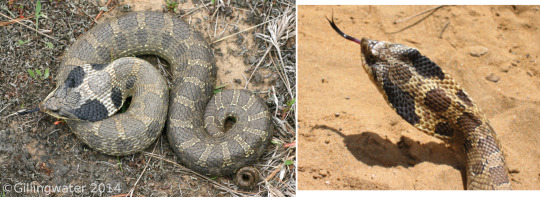
(like cobras, this hood is made by FLEXING THEIR NECK RIBS. which: gross – image source x)
This superficially makes them look like a cobra, but what they’re actually trying to do is make themselves seem bigger, and therefore scarier. Possibly those dark spots on their neck helps with that!
Any resemblance to real-life Eurasian cobras, real or fictional, is purely coincidental
Also, it makes its mouth do this:

(Snakes that SCREAAAAAAAM. – image source)
honestly, if I didn’t already know that hognose snakes were harmless, this would ABSOLUTELY make me leave it the hell alone
But if all of that^ is unsuccessful at scaring away the predator, the hognose snake pulls its signature move: playing dead
If you think that is a lame signature move, then you are wrong, because hognose snakes put EVERYTHING into their performance and I love them for it.
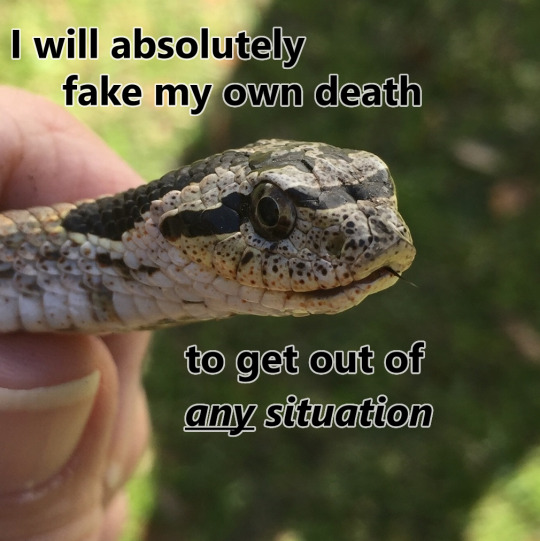
(they’re serious, they’ll do it! – image source)
((I’m actually going to stick the rest of this under a read-more, bc the pictures of the alive-and-physically-fine hognose snakes do kind of look like a legitimately-dead hognose snake, if you don’t know what to look for.
So, uh: cw for a snake being too good at pretending to be dead))
Keep reading
#self reblog#bc i missed last friday#hognose snake#snakes#biology#fun facts#fun fact friday#science#sciblr#science side of tumblr#STEM#adhd in STEM#zoology#ecology#Herpetology#snake
2K notes
·
View notes
